How to choose a snowboard jacket and pants
Shell or Insulated?
Shell Jackets and Pants
Shell outerwear is just like the name suggests, they are a lightweight, water resistant shell, that is made to keep you dry but not warm. Shells can be very useful because you can buy a waterproof shell and use it in all conditions. If it is very cold, add layers underneath it, when it warms up in sprint just wear it without the extra layers.
Insulated Jackets and Pants
Insulated outerwear has insulated material below the water resistant outer layer, to add warmth. The insulation on these jackets is normally made of synthetic or down.
Synthetic insulation can be quite low profile, and are still able to keep you warm if they are wet.
Down insulation is made up duck or goose down, and is by far the warmest option. It will normally have a much puffier look than jackets with synthetic insulation, but it is still very light and can compress easy. The weakness of down is unlike synthetic insulation it won’t keep you warm if it gets wet.
So basically, synthetic insulation can be cheaper, takes up less room and still works to keep you warm if it does get wet. Down Insulation will keep you much warmer, but it is slightly puffier and won’t keep you warm if it does get wet. Not that getting wet is a big problem, with a decent waterproof rating on the outer shell, that shouldn’t ever be a problem.
What is the waterproof rating
The waterproof rating is measured in a complicated sounding way. You will generally find fabric with ratings like 5000mm, 15000mm or 5k and 15k to be short.
The short and easy way is higher numbers are better.
To measure the waterproofness of the fabric, it is pulled tight and a tube with a 1 inch diameter is placed on top of it. The tube is filled with water, and it is checked to see when the water starts to work its way through the fabric.
So on a lower end fabric, if the water will start to come through the fabric when there is 5000mm of water in the tube, then it can be given a 5000mm (5k) rating.
If you can put 20,000mm of water in the tube before it starts to come through, it will have a 20,000mm (20k) rating.
As a rough guide:
5k rated materials will give you decent protection from snow. Normally found on the lower or entry level priced outerwear.
10k will give you much more protection, and will be able to handle wetter snow and more of it.
20k will give you the best waterproofness, and will keep you dry in very wet snow.
What is the breathability rating
Having the most waterproof gear is no good unless the material can breath. Otherwise everyone could wear garbage bags and stay completely dry without a problem.
Whether or not you realise it, you are sweating while you are out snowboarding, and you need that moisture to leave your body quickly so you don’t get cold.
The breathability rating is rated in grams/m2/d which is how much water vapour they will let through a meter squared of material in 24 hours. For short, often the descriptions are shortened so that a fabric with a 10,000g/m2 is shortened to 10,000g.
Similar to the waterproof ratings, as a rough guide you could say that more is better. On the lower end you have 5000g, which is an decent level of breathability, and they go up to and above 20,000.
What is Gore-Tex?
Gore-Tex is the name/brand of a high end very waterproof and breathable fabric, this is separate/higher than the traditional mm/g ratings.
Gore-Tex is a separate brand, though lots of brands use it on their high end outerwear.
The Gore-Tex membrane is the most important part of the fabric, which is a very thin 0.01mm thick layer of expanded polytetraflouroethylene (ePTFE). It has over 9 billion pores per square inch that give it the waterproof, windproof and breathable features.
Gore-Tex comes in two main options – 2-Layer and 3-Layer
2-Layer construction means that the Gore-Tex membrane is bonded just to the outer fabric.
3-Layer construction means that the Gore-Tex membrans is bonded to the outer fabric and the inner lining. There isn’t any movement between the layers, so it is more durable.
If you want the best waterproof and breathable outerwear, look a buying some that is made with Gore-Tex, they aren’t cheap but do the best job.
What are taped seams?
There is no point having a super waterproof jacket if water can get in through the seams. When the material is being sewed together, the needle will leave tiny holes. To stop that they use seam sealing, or seam taping.
The taped seams mean that a thin waterproof tape is applied to the seams, which will stop moisture or water seeping its way through.
There are two main types of taped seams – Critical Seams and Fully Taped Seams.
Critical Seams means that just the major seams that are exposed to the weather are taped, while the less important seams are left as normal. Jackets and pants with just their critical seams taped are usually cheaper.
Fully Taped Seams means that every seam on the jacket or pants are sealed. This is a feature found on higher end, more expensive outerwear.
Extra Features that aren’t necessary but definitely help
Jackets
Waterproof zippers
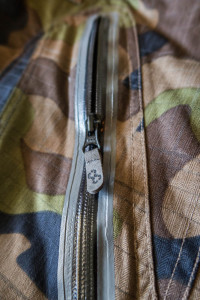 Waterproof, or water resistant zippers help stop moisture getting in though the zippers. Mainly found on outerwear with 15k/15k+ or Gore-Tex fabric.
Waterproof, or water resistant zippers help stop moisture getting in though the zippers. Mainly found on outerwear with 15k/15k+ or Gore-Tex fabric.
There is a soft plastic above the teeth of the zip that is pressed together when the zipper is done up. So far I have never had a problem with water getting in through these zips, even spending all day out in the wet rain/snow.
Underarm Vents
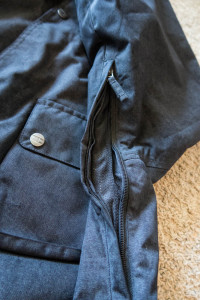 Mesh lined underarm vents are very useful, if you are hiking or the weather gets warmer, you can unzip the vents to help let hot air out.
Mesh lined underarm vents are very useful, if you are hiking or the weather gets warmer, you can unzip the vents to help let hot air out.
The mesh lining helps stop big chunks of snow getting in if you ride with the vents open.
Powder Skirt
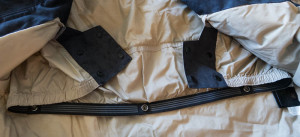 A powder skirt or waist gaiter is a stretchy skirt that clips around the bottom of the jacket to make a tight seal around your pants. They are made to keep snow (especially light powder) from getting up and under your jacket.
A powder skirt or waist gaiter is a stretchy skirt that clips around the bottom of the jacket to make a tight seal around your pants. They are made to keep snow (especially light powder) from getting up and under your jacket.
Wrist Gaiters
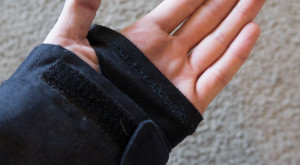 Wrist gaiters a similar to a powder skirt, but they are designed to stop snow from getting up and into your sleeve.
Wrist gaiters a similar to a powder skirt, but they are designed to stop snow from getting up and into your sleeve.
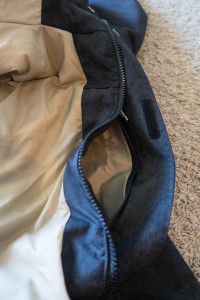 Media Pocket
Media Pocket
Media pockets are normally a pocket on the chest of your jacket that are used for your phone or ipod. The jacket pictured lets you get to the pocket while the jacket is still done up, and there is a small opening in the top of the pocket that lets you run earphones up and in through the jacket.
Pass/Ticket Pocket
Pass pockets are especially useful for people who ride at mountains who use RFID gates. So that the RFID works (away from your wallet) they are sometimes on your arm or built into the powder skirt.
Jacket to Pants connection
There are a few brands that will let you connect your jacket to your pants. Usually there are snaps that connect the powder skirt of the jacket to the belt loop on the pants. They help to keep snow out, and stop your pants from falling down or your jacket from riding up. Not really a make or break feature, but handy if you have it.
Pants
Boot Gaiters
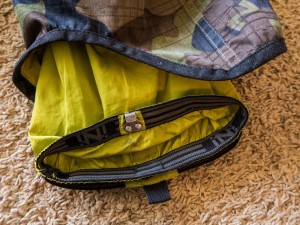 Almost every pair of pants will have this, which is a tight gaiter (similar to a powder skirt) that fits over your boot and makes a tight seal. Beginners often make the painful mistake of putting the gaiter inside the boot, which can hurt when the metal boot loop digs into your shin.
Almost every pair of pants will have this, which is a tight gaiter (similar to a powder skirt) that fits over your boot and makes a tight seal. Beginners often make the painful mistake of putting the gaiter inside the boot, which can hurt when the metal boot loop digs into your shin.
There is a grippy rubber lining on the inside of the gaiter, which will help if stay down over the boot. As a backup, you can connect the little metal hook to the laces on your boots.
Crotch or Thigh Vents
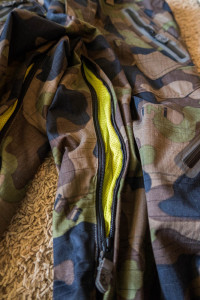 Just as useful as underarm vents on jackets, crotch or thigh vents help to get rid of extra heat when you are out hiking or riding in warm weather.
Just as useful as underarm vents on jackets, crotch or thigh vents help to get rid of extra heat when you are out hiking or riding in warm weather.
So what level gear do I need?
If you are going to be riding in cold areas, look at insulated jackets. If it is really cold, look for down insulation. Another option is to get a waterproof shell, and some warm mid layers to wear underneath it.
If it is cold and dry weather, focus more on having good insulation/warm mid layers rather than a super high waterproof rating.
If you ride where it is warmer and wetter, make sure you get a jacket with good waterproof/breathability ratings.
Have a look at some Jackets and Pants
If you already know the jacket or pair of pants that you want, this search page will show you what stores have it in stock or on sale.
Find the best price on the How to choose Snowboarding Outerwear